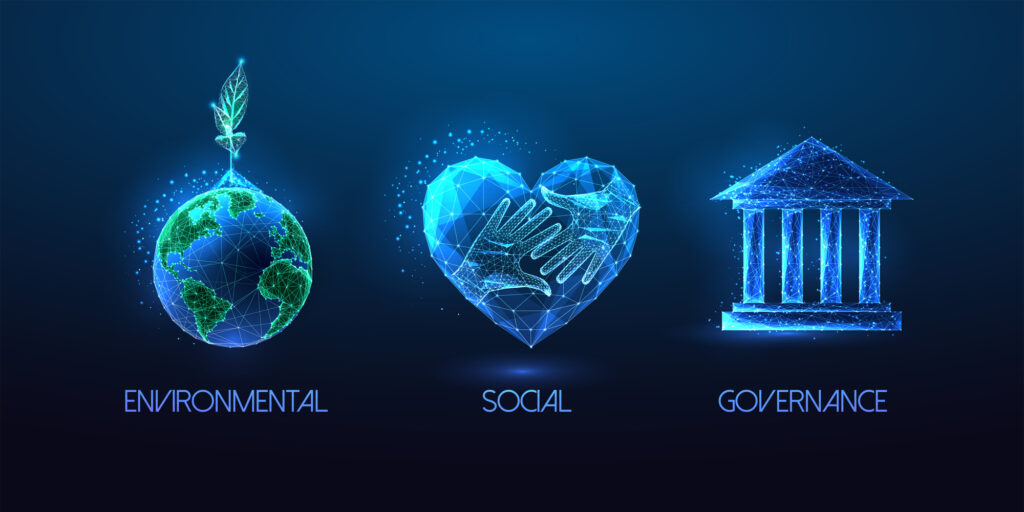
The implementation of the Corporate Sustainability Reporting Directive (CSRD) mandates that European companies of a particular size must report their Environmental, Social, and Governance (ESG) information.
According to McKinsey, “... while more than 95 percent of S&P 500 companies issue a sustainability report, very few fully integrate environmental, social, and governance (ESG) into their equity stories…”
ESG can be described as a set of practices (policies, procedures, metrics, etc.) that organisations may use in order to limit the potential negative impact on the environment, society at large, and their organisation from carrying out their business.
Recently ESG has become a hot topic because the first reporting cycle from businesses will be due in 2025, based on data from financial years starting on or after 1 January 2024.
Investors are also keen to find proof points that the companies that they invest in are delivering on their ESG strategy, generating the desired results or that they are proactively addressing ESG.
As organisations now are starting to really dig into the ESG reporting obligations, this article will help highlight how Master Data Management (MDM) can become an integral part of enabling organisations to meet their ESG reporting needs.

What is MDM?
A Master Data Management or MDM solution can be applied by enterprise organisations to manage their most critical data assets (known as master data) and is often referred to as the “single source of truth”. A single source of truth for collecting data, simplifies decision-making processes, building trust amongst stakeholders because everyone knows they can rely on the same dataset for accurate, reliable information.
An investment in MDM should be regarded as a building block on which subsequent business initiatives can be built, based on access to trustworthy data that facilitates effective business decisions.
The success of an MDM initiative for ESG reporting will hinge on securing commitment and endorsement across your organisation from key stakeholders. And to get the necessary stakeholder buy-in, you’ll need to be able to demonstrate the added value that can be achieved by leveraging MDM to successfully deliver your ESG reporting.
What are the ESG reporting needs that an MDM solution would help address?
MDM as the single source of truth, is an effective mechanism to collect and integrate ESG data from your various internal and external sources. At the same time, its structure can be used to help you define and implement validation rules and data cleansing procedures to identify and rectify errors, inconsistencies, and redundancies in the data before they can impact your reporting.
MDM systems can be an integral part of pulling together processes that ensure compliance with regulatory standards, helping to develop data security protocols and privacy measures to protect sensitive ESG data.
By harmonising ESG data across the many different sources and systems, organisations can generate comprehensive insights that on reflection will help them to identify emerging trends, and assess performance against their ESG goals and targets.

So - what are the steps that you should be taking to implement an MDM solution?
Step 1 - Planning
The first step to consider when implementing an MDM solution for ESG reporting involves comprehensive planning, to prepare a solid foundation from which the MDM system can be leveraged.
In order to create an effective plan, it's essential to gain a deep understanding of the scope of an organisation's ESG reporting needs and objectives. This entails identifying the specific ESG metrics that need to be tracked, as well as flagging and involving key stakeholders and resources for their input.
Planning also involves conducting a thorough assessment of existing ESG data sources, understanding the format and structure of the data. By mapping out the existing data ecosystem, organisations can identify potential gaps, inconsistencies, and redundancies that need to be addressed during the MDM implementation process.
Step 2 - Design
During the design phase, as well as discussing how to make reporting intuitive so that performance can be visualised and analysed effectively - it is also a time to translate an organisation's ESG reporting needs into a structured MDM solution. This includes determining the data model, which defines the types of ESG data to be captured, such as environmental metrics (e.g., carbon emissions, water usage), social indicators (e.g., diversity, labour practices), and governance practices (e.g., corporate policies, board structures).
The design process involves establishing data governance policies and procedures which includes defining data ownership, access controls, and data stewardship roles to ensure the integrity, security, and compliance of ESG data.
An MDM solution needs to be flexible to be able to adapt to changing business needs and technological advancements and scalable to ensure that the system can accommodate future growth and evolving ESG reporting requirements.
Step 3 - Building
Once the design is complete, organisations transition to the building phase, where they translate the design specifications into tangible components of the MDM solution.
This phase involves the development and configuration of data integration processes, data cleansing routines, and data enrichment mechanisms to ingest, harmonise, and manage ESG data from diverse internal and external sources.
Building an MDM solution may also need some customisation or system configuration to address unique organisational requirements and compliance standards in a particular vertical.
Step 4 - Testing
Organisations conduct various levels of testing, including unit testing, integration testing, and user acceptance testing, to identify and rectify any defects or issues.
Data quality checks, validation rules, and adherence to ESG reporting standards are rigorously evaluated during this phase to ensure the accuracy and consistency of ESG data.
Step 5 - Deployment
Following successful testing and validation, the MDM solution is ready for deployment into the production environment. Deployment involves executing data migration processes, configuring system settings, and conducting training sessions with users.
After a successful MDM implementation there is also a need to maintain ongoing monitoring, support, and optimisation of the solution with regular updates and assessments of how the system is performing.
Check out our video series on How To Get Started on Your MDM Journey.

Integrating ESG and MDM, what are the benefits?
By integrating ESG and an MDM solution, it ensures that the ESG data will be governed by consistent quality standards and validated through robust data management processes.
Plus, by automating data workflows within the MDM framework, it can reduce the manual effort required for tasks and minimises the risk of errors or inconsistencies in ESG reporting.
Enhanced data quality and integrity come from centralising ESG data within an MDM framework, organisations can then establish their data governance policies, implement their data validation rules, and enforce data quality controls to make sure that their ESG data is accurate and complete.
By establishing a common understanding internally of ESG metrics, organisations can foster collaboration between the various stakeholders, building credibility and trust, that a business is committed to ESG transparency and accountability.
Is ESG part of your corporate strategy?
Integrating ESG considerations into your corporate strategy requires a structured approach that aligns ESG principles with the organisation's overarching goals and values.
And the main starting point for most organisations is in defining their ESG vision and mission, communicating the organisation's long-term aspirations and values to internal and external stakeholders.
Next Steps
Not all aspects of ESG however, are priorities for all organisations, and it is unrealistic to expect that as a business that you’ll not have to make trade-offs within and among the various ESG dimensions, or that they can be an industry leader on every topic.
So, get in touch to have a conversation about rolling out an MDM solution for your ESG reporting.
Achieving success with your MDM project requires a lot of preparation. There are many things to consider and it can be hard to figure out where to start especially with this new legislation around CSRD.
Book a free consultation call with us today to learn more about how we can help.

As organisations prepare to meet the growing demands of Environmental, Social, and Governance (ESG) reporting in 2024, this article highlights the significance of Master Data Management (MDM) as the cornerstone for compiling ESG reporting.
We will delve into the essentials of ESG reporting, and the role of MDM in helping to streamline the data governance processes. Moreover, discover the benefits and challenges of ESG reporting, the importance of a data-first approach, and practical strategies for leveraging MDM to empower ESG initiatives.
Background
The Corporate Sustainability Reporting Directive or CSRD entered into force on 5th January 2023, with EU Member States required to implement its provisions into national law and regulation by 6th July 2024.
The CSRD was a new piece of EU legislation concerning the social and environmental information that companies have to report, with the aim to address the disparity between investors’ information needs and the corporate sustainability information that is available. The first reporting cycle is due in 2025 based on data from financial years starting on or after 1 January 2024.
For the first three years, the application of the requirements will be on a “comply or explain” basis, because for many companies not all the necessary information regarding their entire value chain is going to be readily accessible.
So, as companies start to build their data foundations in anticipation of upcoming reporting and disclosure requirements they must be able to detail the efforts made to obtain the necessary information, reasons why it cannot be obtained and their plans going forward to obtain the information.
The CSRD directive will directly impact large companies (estimated 50,000+), as well as listed SMEs (Small and Medium sized Enterprises), who will now be required to report on sustainability. The directive however does exclude “micro” companies, those with less than 10 employees or below EUR 20 million in turnover.
Read more: Why Master Data Management should become the foundation for ESG reporting.

ESG – what it is and why it matters
ESG stands for “Environmental, Social and Governance.” ESG can be described as a set of practices (policies, procedures, metrics, etc.) that organisations implement to limit the negative impact of their business on the environment, society at large, and governance bodies.
So fast forward to 2024 and investors are increasingly looking for companies that prioritise sustainability and ESG considerations to guide their investment decision-making. As a result, many businesses have begun to integrate ESG into their operations and business strategies.
When an organisation is implementing ESG, for each element where is the focus?
In regards to ESG reporting, Environment focuses on a company’s adherence to pertinent regulations and their environmental footprint; Social encompasses a company's impact on society at large and its stakeholders (employees, customers, communities, suppliers, and other parties), and Governance relates to the internal systems and structure of corporate decision-making, oversight, and accountability that will be reported on.
Executing ESG reporting demands accurate and comprehensive data across multiple dimensions and sources, so a Master Data Management (MDM) system is an ideal structure to provide the necessary framework to ensure data integrity and consistency.
By implementing MDM, an organisation has the tools to create most importantly a single source of truth for its data. Using MDM to facilitate data collection, cleansing, and standardisation to ensure that the reported data is reliable, trustworthy, and meets regulatory compliance.
Read more: What is the expected financial impact of investing in your Master Data Management (MDM)?
What are the benefits and challenges of ESG reporting for organisations?
Companies subject to the CSRD directive will have to report according to the European Sustainability Reporting Standards (ESRS). The CSRD also makes it mandatory for companies to have third-party assurance and external auditing of the sustainability information that they report.
The new EU directives will ensure that investors and other stakeholders have access to the information they need to assess investment risks and will also create a culture of transparency about the impact of companies on people and the natural environment.
How to understand and identify your ESG data
There are a number of different types and sources of ESG data that organisations need to collect and report on, we list a few of the major ones below.
For ESG, Environmental data includes metrics such as carbon emissions, water usage, waste management and pollution prevention, energy consumption, renewable energy usage, and biodiversity impact. This data helps stakeholders understand an organisation's environmental footprint and its efforts towards conservation and sustainability.
Secondly, Social data evaluates how a company manages its relationships with its stakeholders i.e. the workforce, communities, and broader society. This includes information on labour practices, diversity, human rights, community engagement, health and safety standards, privacy protection and product safety and quality. By reporting on social metrics, organisations demonstrate their commitment to employee welfare, respect for human rights, and positive contributions to the communities in which they operate.
Thirdly, Governance focuses on a company's internal controls, transparency, business ethics, and practices that guide decision-making and oversight within the organisation. Through governance data, organisations showcase their commitment to accountability, integrity, and transparent corporate governance practices.
Read more: What Is Stibo STEP & How Can It Help Your Business?
As a business understanding your ESG priorities
What can be confusing for an organisation is to understand what ESG issues could potentially impact their business operations, reputation, and long-term sustainability the most.
So, they adopt a materiality assessment, a process to prioritise and focus efforts on those issues that have the greatest potential to influence the organisation's performance and stakeholders' perceptions.
With this materiality criteria an organisation can then prioritise ESG issues that serve as the focal points for developing strategies, setting targets, and implementing ESG initiatives.
Taking a collaborative approach also with stakeholders through for example consultations and surveys, provides valuable insights into stakeholder interests and needs. And by embedding ESG metrics into key performance indicators (KPIs) and reporting frameworks, organisations drive accountability and transparency throughout their operations.
Organisations need to identify internal and external sources of ESG data, extensively mapping the data sources and establishing robust data governance processes to ensure accessibility of ESG data across the organisation.
Read more: How to Get Started on Your Master Data Management (MDM) Journey.

Taking a data-first approach to ESG reporting
The importance of a data-first approach to ESG reporting lies in its ability to enhance the credibility and trustworthiness of the reported information reducing the risk of misinformation or misinterpretation.
Accurate and reliable ESG data provides stakeholders with a clear and comprehensive understanding of an organisation's environmental and social impacts, as well as its governance practices.
Accurate data also enables organisations to benchmark their performance against industry peers, track progress over time, identify trends and demonstrate continuous improvement in ESG performance.
How to use MDM to empower your ESG initiatives
One of the key roles of MDM in ESG reporting is to facilitate data governance with rules, standards, and workflows for managing ESG data throughout its lifecycle. MDM ensures that ESG data is captured, validated, and updated consistently across various business processes and systems, thus enhancing data quality and integrity.
With a single source of truth for ESG data, an MDM system can generate comprehensive and reliable reporting and disclosures that meet the needs of internal and external stakeholders.
MDM enables an organisation to create a centralised repository or data hub for ESG data, which can then serve as a single source of truth across the organisation. By consolidating disparate data sources and establishing a unified data model, MDM ensures that ESG data is consistent regardless of its origin or format.
An MDM system allows an organisation to implement data quality controls and validation checks, and enforce data privacy and security protocols to ensure the integrity and confidentiality of ESG data organisation wide.
Moreover, MDM facilitates data integration and enrichment, streamlining the process of aggregating, and reconciling ESG data from various sources internal and external, and by uncovering deeper insights enabling more accurate and comprehensive analysis and reporting.
Conclusion
In summary, MDM acts as the foundation for compiling ESG reporting by ensuring data accuracy, integrity, and consistency across the organisation, enabling organisations to meet what will be going forward the growing demands of ESG reporting in an efficient and effective manner.
Next Steps
Get in touch to roll out MDM for your ESG reporting.
Achieving success with your MDM project requires a lot of preparation. There are many things to consider and it can be hard to figure out where to start especially with this new legislation around CSRD.
Book a free consultation call with us today to learn more about how we can help.

Master Data Management (MDM) will play a pivotal role in helping larger organisations compile and collate the necessary data that is required to fulfil the new European Union’s ESG (Environmental, Social, and Governance) impact reporting directive, slated to take effect for the 2024 financial year.
The change in having to publish findings on a company’s impact across the ESG elements will affect 50,000+ organisations who will be required to detail how their business strategy will mitigate the risks associated with the ESG issues and figures that they disclose in their reporting.
What are the ESG elements that companies will have to report on?
In regards to ESG, each element in the required reporting would need to be addressed and data provided on the following:
Environment: This focuses on a company’s adherence to environmental regulations and the impact they have on the natural environment; from factors such as carbon emissions, to energy consumption, pollution prevention, water and marine resources, biodiversity, resource conservation, waste management, renewable energy and efforts towards mitigating climate change.
Social: This encompasses a company's impact on society at large and its stakeholders (employees, customers, communities, suppliers, and other parties), evaluating how a company manages its relationships with those affected by its operations. Social factors include employee welfare, labour standards, diversity and inclusion, human rights, community engagement, product safety, customer satisfaction, privacy protection, and social contributions.
Governance: The internal systems and structure of corporate decision-making, oversight, and accountability will be reported on. Focusing on a company's internal controls, transparency, business ethics, and effectiveness of the board. Key governance factors include board composition, executive compensation, shareholder rights, risk management, anti-corruption measures, disclosure practices, and adherence to legal and regulatory requirements.

New CSRD regulations means ESG reporting for many more companies in Europe
In early 2023, the Corporate Sustainability Reporting Directive (CSRD) entered into force. This was a new piece of European Union legislation, a directive created to modernise and strengthen the current rules concerning the social and environmental information that companies have to report.
The CSRD directive will directly impact large companies, as well as listed SMEs (Small and Medium sized Enterprises), who will now be required to report on sustainability. The directive however does exclude “micro” companies, those with less than 10 employees or below EUR 20 million in turnover.
Updating existing reporting directives in the EU
The CSRD aims to strengthen and extend the scope of the existing EU reporting requirements from its predecessor, the Non-Financial Reporting Directive (NFRD) that had impacted 11,700 companies, based on a much larger business size criteria for inclusion.
Companies subject to the CSRD will have to report according to European Sustainability Reporting Standards (ESRS). The CSRD also makes it mandatory for companies to have third-party assurance and external auditing of the sustainability information that they report.
In 2022, the European Financial Reporting Advisory Group (EFRAG) released its first draft of the ESRS reporting standards, which will fall under the CSRD.
Within the reporting standards the CSRD values sustainability metrics alongside environmental performance, with a special focus on how organisations monitor their social impact, such as employee health, human rights, bribery, anti-corruption and diversity. And there are several data-intensive disclosures within the ESRS covering greenhouse gas emissions, energy, waste, water, recycling and social metrics.
Why focus on reporting ESG?
The new EU directives will ensure that investors and other stakeholders have access to the information they need to assess investment risks arising from climate change and other sustainability issues. They will also create a culture of transparency about the impact of companies on people and the environment.
The first companies who will have to apply the new reporting rules will do so on their 2024 financial year data, for reports published in 2025.
Existing legislation such as the EU's Non-Financial Reporting Directive (NFRD) had already set out rules for the disclosure of non-financial information by certain large and listed companies. Companies that are already subject to the NFRD will need to report on their 2024 data.
As ESG considerations gain prominence globally, organisations impacted by the EU’s CSRD announcement need to start building their data foundations in anticipation of upcoming reporting and disclosure requirements.
Longer term, the intended outcomes of CSRD will contribute to Europe’s 2050 climate-neutrality target, and European Green Deal objectives.

What is the connection between the DPP and ESG reporting?
The EU's Digital Product Passport (DPP) and ESG reporting are interconnected as they both contribute to sustainable practices and transparency within organisations.
The DPP is a digital framework that requires a manufacturer or reseller to gather detailed information on their product's environmental impact, its lifespan, and repairability. The DPP initiative aims to enhance sustainability by promoting resource efficiency, circular economy principles, and the reduction of waste.
Companies will need to source data for the DPP on a product's material composition, energy consumption, carbon footprint, and other relevant information.
When it comes to the ESG elements, the DPP feeds into the reporting its environmental data around a products’ sustainability attributes and progress towards sustainability goals.
By linking the DPP with ESG reporting it can help stakeholders evaluate a company's environmental performance and make informed decisions based on the disclosed information.

So, how can having an MDM system help?
As ESG reporting requires accurate and comprehensive data across multiple dimensions, MDM provides the necessary framework to ensure data integrity and consistency.
By implementing MDM, organisations can centralise and govern their ESG data, creating a single source of truth. MDM facilitates data collection, cleansing, and standardisation, ensuring that information from various sources aligns with reporting requirements.
Having an MDM structure enables organisations to establish data quality rules, validate data against predefined criteria, and resolve any inconsistencies.
MDM also helps in linking and harmonising data from diverse systems, enabling a holistic view of ESG metrics. It ensures that the reported data is reliable, trustworthy, and meets regulatory compliance.
In summary, MDM acts as the foundation for compiling ESG reporting by ensuring data accuracy, integrity, and consistency across the organisation, enabling organisations to meet the growing demands of ESG reporting in an efficient and effective manner.
If you want to learn more about how to get started, book a free consultation and let’s explore how we can help you get the most from your MDM investments when compiling your ESG reporting.